This is a trip I’ve wanted to do for a long time. I’ve paddled from Skamokawa to Astoria several times in the last couple of years, and the last time I went down there, I felt like I had energy to spare and joked with my clients that we should paddle back with the flood tide. They looked at me like I was crazy…
It is about 19 miles or so to paddle from Skamoakwa to Astoria, and so doubling that would come in at just under 40 miles, the longest paddling day I’ve ever done. When Ginni and I were building the schedule a few weeks ago, we were looking for a compatible tide series for this trip, and the only one that was available to us demanded a 4 AM departure from Skamokawa. We looked at each other and said, “Why not?”
The plan was to paddle to Astoria on the ebb tide, arrive around 8:30 or so, and eat breakfast at the Blue Scorcher bakery, just a couple of blocks up the hill from the Maritime Museum. Then when the tide turned, we would head back upstream to Skamokawa.
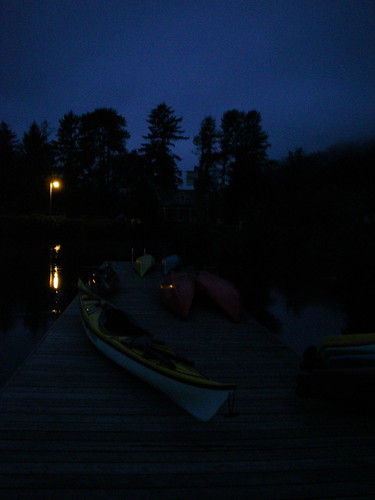
So we dragged our butts out of bed at an unnatural hour, made our way down to the dock, and set out downstream, leaving Skamokawa at 5 AM. There was a strong current flowing out and my new GPS showed us zipping along at 7 mph. Ginni borrowed the GPS and got her kayak up to 8.5 mph for a moment.
Down below Miller Sands, where the shipping channel turns towards Astoria, the dredge equipment was working, and we also saw this buoy, tangled in several hundred feet of gillnet. I’ll digress here for a minute. First of all, these nets are not cheap! Why anybody would lay out thousands of dollars worth of net in a place where they would risk tangling it this severely is beyond me. And it wasn’t just snagged on the end, either; whoever did this evidently drifted down on this buoy with the net strung out for hundreds of feet on both sides of it. But what really gets me is that after it tangled on the buoy, they just cut it loose and abandoned it, as a hazard to fish and to navigation. The bright side of this story is by the time we passed this buoy again on the way home, the guys running the dredge equipment had removed the net and piled it on one of their barges.

That last leg of the paddle from Rice Island to Astoria is a long one, since the destination is in plain sight for so long, without seeming to get much closer. Finally we starting pulling up on Tongue Point, just east of town.
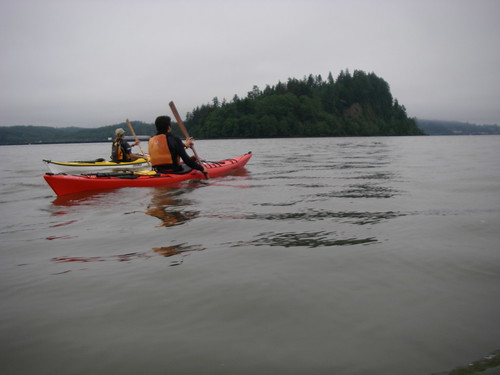
By this time, we were starting to smell the cinnamon rolls and coffee!

Not long after, we were pulling into the East Mooring Basin to see if there were any lingering sea lions hanging around. We only saw one, apparently not with the program as most of the rest of the gang is off to California to the breeding grounds.

Here’s a great name for a fishing boat, huh? And a bottom dragger to boot! Last year, the trawling industry here was hit with scandal when they were caught dumping and grinding up protected rockfish bycatch to prevent their whiting season from being shut down. Nice, huh? Little was done about it and they continued to fish for whiting even after being caught cheating the system. And this year, when salmon fishing is sharply curtailed all up and down the coast, the trawl industry gets to kill 11,000 Chinook salmon as bycatch. Can you tell I’m not a fan of the trawl boats?
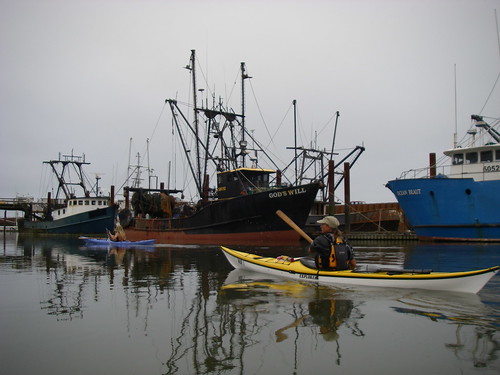
I don’t know much about this boat, except that it is an old, out of service pilot boat. It is a beauty though, with such a great color scheme. Here’s what I found when I googled it.
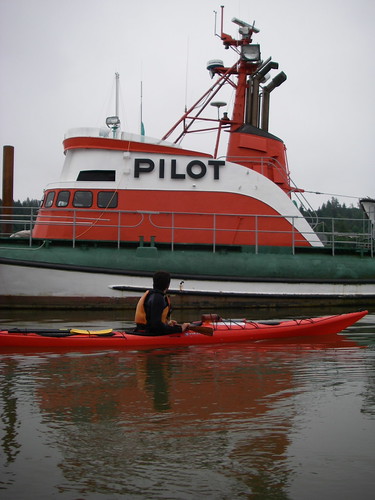
We paddled under the old red cannery building that was so damaged in last winter’s windstorm and then up to the dock at the Columbia River Maritime Museum. The mileage to this point, measured by GPS, was 19.4 statute miles and we did it in 3 hours and 15 minutes. Not too bad! But we knew the return trip wouldn’t be so quick…
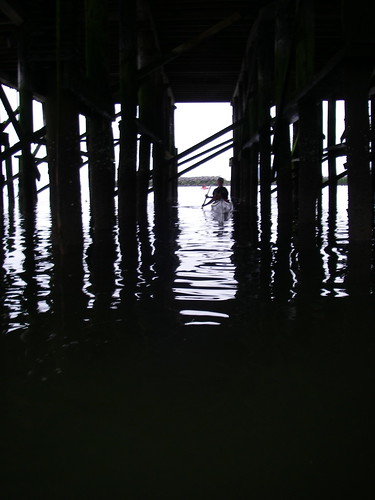
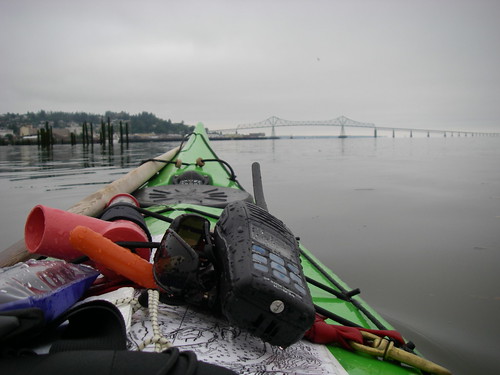

After changing into “cilvilian” clothes and stowing the kayaks, we headed up to the bakery, where we spent an hour or so hanging out drinking coffee and eating breakfast. Josh looks like he’s still asleep though!
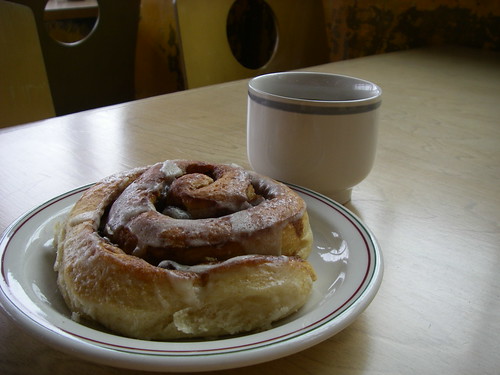
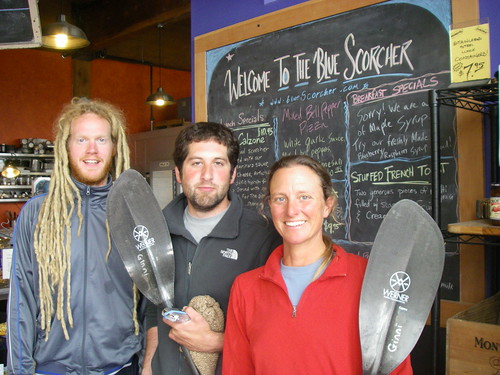
We got back on the water about 10:30, when we saw the ships at anchor starting to swing around with the change of the tide, and headed back past Tongue Point, where we saw four or five sturgeon jumping and rolling in just a few hundred yards. What makes them do that?
While our average speed on the downriver leg was 6.4 mph, now we were only averaging 4.3, and as we pulled alongside Rice Island and the dredge equipment again, the wind was starting to blow. We stopped on Miller Sands for a quick break and then continued on.
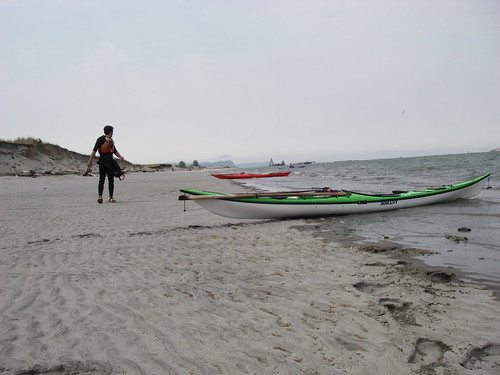
This part of the trip was much less smooth than the first part, and we were soon surfing wind waves, and, around 30 miles or so, were starting to feel a bit tired! We took another break below Jim Crow Point and then got back to work for the last 5 miles or so. This part of the trip had only taken 50 minutes earlier in the day, now it took almost twice that! As we were pulling up next to Skamokwa, we were actually starting to notice an ebb current again.

We finished the trip back at our home dock at 4 PM, eleven hours after we had begun. We covered 39.2 miles in eight hours and five minutes of paddling time, according to the GPS. We were tired, my drysuit was leaking and our boats seemed heavier than ever before as we carried them up the ramp to the paddle center. I joked that next time we should do the same trip in whitewater boats, just to keep things interesting. Oddly, there wasn’t a lot of enthusiasm for that idea….




Recent Comments